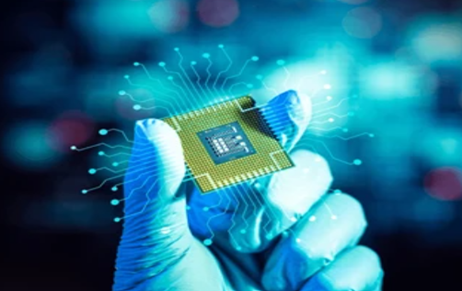Currently, semiconductors act as the foundation for advancements in the technological field such as smartphone…
Patent applications for blockchain technology : A Comparative Study Between India And U.S.A
Introduction
A Comparative Study Between India And U.S.A Patent applications for blockchain technology have been fast increasing around the world. Blockchain patents are being filed worldwide in the financial industry, non-financial sector (real estate), and other generic areas, according to a comprehensive assessment and analysis of the blockchain patent landscape. Many people associate blockchain with cryptocurrency, but the technology is more akin to a secure and transparent digital record that serves as the foundation for patentable ideas. Currently, every significant tech business is looking at how they might apply blockchain technology to their particular industry, and corporations like IBM are obtaining hundreds of patents in order to position themselves as a blockchain standards leader. With the evolution of blockchain and the introduction of fresh blockchain-based technologies, it is projected that the number of patents in this area will rise, increasing the likelihood of blockchain patent disputes and blockchain patent licencing.
What is Blockchain?
Blockchain is a distributed and shared ledger technology that uses a peer-to-peer network to record transactions and monitor assets in a highly reliable, secure, and efficient manner. The assets can be tangible (car, house property, etc.) or intangible (copyrighted material, patents, brands, etc.). Blockchain is used to construct the cryptocurrency bitcoin, although the technology’s applications extend far beyond bitcoin. Although ledgers have been used in business since the dawn of time, blockchain has some unique qualities, which are listed below. Some of them include: Each network participant copies and holds a copy of data linked to each transaction; no third-party verification is required, and data cannot be altered or tampered with.
All of this is possible because of the way blockchain is implemented. The term ‘blockchain’ implies that the technology is decentralized. A blockchain is a collection of interconnected blocks. Each block represents a single record and includes a header, transaction-specific details, a timestamp, and a ‘hash’ for the preceding block to which it is linked (the first block in a blockchain is the so-called genesis block). As a result, in a blockchain network, all network participants (nodes) have access to all of the network’s transactions. Any attempt to modify a block will be quickly identified as invalid and rejected by all network participants.As a result, a blockchain network is tamper-resistant and unchangeable. Furthermore, no third-party validation or authentication is required. In comparison to legacy ledger systems, this makes blockchain more efficient and dependable.
Indian Scenario
It has been suggested that block chain-related discoveries may not be patentable because most block chain-based services are simply repurposing an existing notion (blockchain technology). Algorithms using mathematical theory and/or computer programmes are at the heart of blockchain services. Algorithms and computer programmes may not be deemed inventions in the sense of Section 3(k) of the Indian Patents Act. Computer programmes, per se, are patent-ineligible subject matter, according to Section 3(k) of the India Patents Act, 1970. The meaning of the term ‘per se’ has been a source of contention.
Recent Indian Patent Office patent grants appear to show that computer-related inventions are patentable under Section 3(k) if they give a technical solution to a technical problem by providing a practical application or an improved technical impact of the underlying software. A blockchain-based service invention may be patentable if, after thorough examination of the claims, it provides a technical solution to a technical problem and significantly enhances the underlying technology. However, how such improvements are to be determined remains a mystery. As previously stated, blockchains are lists or databases used to record transactions. According to the 2017 CRI Guidelines, a ‘database’ is a ‘computer programme per se,’ and hence is not patentable under Section 3 (k) of the Patent Act.
The Delhi High Court, while interpreting the word per se in the case of Telefonaktiebolaget Lm Ericsson v. Intex Technologies (2015), ruled that “any innovation which includes a technical contribution or has a technical effect and is not solely a computer programme per se” is patentable. This interpretation was once again upheld by the single judge of the Delhi High Court in Ferid Allani vs Union Of India & Ors.(2019) ,wherein it was held “If the invention demonstrates a “technical effect” or a “technical contribution‟ it is patentable even though it may be based on a computer program.” Further, the judge also observed, “Innovation in the field of artificial intelligence, blockchain technologies and other digital products would be based on computer programs, however the same would not become non- patentable inventions – simply for that reason.”
It’s debatable whether or not block chain-based inventions are eligible. On one hand, Indian law permits computer-related inventions; while on the other hand, it prohibits the granting of patents to certain such inventions. Patent attorneys have remarked that open-source technologies such as bitcoin are difficult to patent, and even when patents are granted, they are difficult to defend. On a general scale, it may be claimed that current regulations and procedures must be streamlined in order to allow these system-generated ideas to be granted patents. On the other hand, with various roadblocks and ambiguities remaining in place regarding patentability and other difficulties, a more thorough examination of the issues is required.
U.S. Scenario
The USPTO is known for being innovative and innovator-friendly, and it has been a trailblazer in terms of patentable subject matter. Patents for huge, diverse inventions have been issued under the ostensibly limited four categories of patentable inventions (processes, machines, manufactures, and compositions of matter). The USPTO’s permissive attitude is frequently stated as “anything under the sun is patentable” (this often-repeated quote is, among others, attributed to Francis Gurry, former DG of WIPO).In Diamond v Chakrabarty, 447 US 303, USPQ 193 (1980) ,since bacterium was a ‘manufacture’ and/or ‘composition of matter,’ it was decided that whether an innovation relates to live matter has no bearing on patentability. This watershed ruling paved the door for biotechnology to emerge as a new frontier for innovation. The Board of Patent Appeals and Interference determined in ex parte Allen, USPQ2d 1425 (Board of Patent Appeals and Interference 1987), that non-naturally occurring polyploid Pacific Oysters could be the subject of patents, permitting animal forms to be patented. The Commissioner of Patents and Trademarks later determined that non-natural, non-human multicellular animals were patentable subject matter. The US Congress, on the other hand, has ruled that claims involving human organisms are ineligible. Human treatment methods, including surgeries, are patentable in the United States.
However, the USPTO’s liberal stance is not limited to the subject of living creatures. Amazon’s ‘one-click ordering’ patent (US 5960411, issued September 28, 1999) was a first-of-its-kind business technique patent. The effective integration of the patented technology in e-commerce not only indicated that Amazon had the trust of its consumers (who maintained their personal details on Amazon’s website) but also enabled Amazon to pursue the patent against its rivals and afforded extra cash through licencing. Amazon was able to expand its platform beyond bookselling to become a full-fledged worldwide e-commerce company thanks to the technology.
In the field of computer-implemented technologies, less well-known but equally interesting patent grants concern methods for boosting reading and understanding speed (US 6,056,551 granted on May 2, 2000). Due to the vast number of students and professionals who want to improve their reading and comprehension abilities, this invention is reaping commercial rewards through annual subscriptions.
Limitations of blockchain technology
The data in a block of the blockchain is immutable, which means it cannot be changed or erased. This is a benefit, but it also means that data cannot be modified or deleted if necessary. The blockchain stores data in small bits, whereas traditional databases may store enormous amounts of data (such as photographs, videos, and documents).Although blockchain eliminates the need for third-party validation, auditing, or regulatory oversight, a recent news report (Times of India, November 27, 2021) estimated the volume of money laundering in cryptocurrency transactions via blockchain to be in the order of INR 4000 crores in the previous year alone, suggests that governments all over the world will have compelling reasons to track and audit blockchain to combat illegal activities, including d. The government is expected to ban all cryptocurrencies bar a few in a law to be introduced in the upcoming winter session of parliament. According to the Financial Action Task Force (FATF), US authorities broke a business called “Liberty Reserve” that had its own cryptocurrency called Liberty Dollars.These limits and barriers also indicate that blockchain has a lot of room for advancement, which could increase the number of patent applications filed.
Conclusion
The number of patent applications for blockchain ideas is indeed high, but the patent eligibility of the vast majority of these applications will not be known for some time. More crucially, the value of patents is skewed, meaning that only a small percentage of inventions are a “runaway success.” This means that a comprehensive grasp of patentability standards, meticulous drafting, and obtaining expedited awards are critical to maximizing the value of blockchain patents. In many ways, the US jurisdiction aids an eager and ambitious inventor/entrepreneur in reaping value from a fast-growing technology like blockchain. However, with various roadblocks and ambiguities still in place in India about patentability and other difficulties, a more thorough examination of the issues is required. With the upcoming changes for India’s industrial development, and various government initiatives supporting it, it’s possible that this thin line between computer-related inventions and technically advanced computer-related inventions will also mark the beginning of block chain technology protection in the Indian patent regime.
Related Blogs : Click here
Author: Anuja Saraswat – a student of B.A.LL.B (Hons.) from NMIMS Kirit P. Mehta School of Law (Mumbai), in case of any queries please contact/write back to us via email vidushi@khuranaandkhurana.com or contact us at IIPRD.



